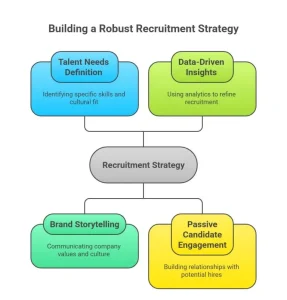Hiring is no longer sifting through resumes. Instead, it’s a competitive battlefield. With a strong recruitment strategy, you’re not only hiring. You’re attracting talent that resonates with your brand. This wa,y you are moving your business forward.
In this article, we discuss what is recruitment strategy is and how you can create one that brings in the best and keeps them.
Why a Powerful Recruitment Strategy Matters
In the market nowadays, top talent has more options than ever. A strong recruitment strategy isn’t a process. It’s your brand’s first impression. This is where potential candidates decide if they want to be part of your story. Companies that prioritize a well-planned recruitment strategy are the ones pulling in passionate, skilled, and motivated individuals. These are the people who will make a difference.
The Key Ingredients for a Recruitment Strategy Plan
Creating an effective recruitment strategy plan isn’t about following a formula. Instead, it’s a blend of techniques, tools, and most importantly. There needs to be a deep understanding of what your ideal candidates value. We share a breakdown of these important components.
1. Define Your Talent Needs with Precision
The foundation of any solid recruitment strategy begins with clarity. Before you post a job, outline exactly what your team needs. Think beyond qualifications and experience. Ask yourself these questions.
- Is it someone with a passion for innovation?
- A knack for client communication?
These specifics help you attract candidates who fit right in with your culture and values. Make it specific and compelling. When candidates see your clear vision, they’re more likely to imagine themselves as part of your team.
2. Craft a Recruitment Strategy That Sells Your Brand
Top candidates want to know what your company stands for. They’re not merely applying for a job. They’re investing their time and energy into your brand. This makes your recruitment strategy as much about your branding as it is about finding talent.
Develop a compelling brand story that emphasizes your unique workplace culture, vision, and opportunities for growth. Display your values on your career page, social media, and in job descriptions. Your recruitment strategy shouldn’t only be about attracting candidates. It should resonate with the ones who will succeed with you.
3. Utilize Data-Driven Recruitment Strategies
Data isn’t only for the sales team. In recruitment, data happens to be a game-changer. There are analytics on previous hiring cycles, employee retention, and performance metrics. It will guide you in refining your recruitment strategy.
Data allows you to pinpoint where top talent is coming from. You understand the patterns better. Your focus on your resources has improved. This recruitment strategy example highlights the power of insight. If data reveals that employees hired through social channels outperform those from job boards, you’ll know where to concentrate your efforts next.
4. Engage Passive Candidates
Don’t wait for resumes to pour in. Active job seekers are great. But some of the best talent might already be happily employed. Build relationships with passive candidates. They are people who aren’t actively looking. But they could very well be enticed by the right opportunity. It’s an often overlooked recruitment strategy.
Social media, your LinkedIn connections, and industry events are all golden opportunities for connecting with passive talent. Regular engagement nurtures a pipeline of potential candidates. They are ready to jump ship when the time is right.

Recruitment Strategy for Startups – Standing Out in the Crowd
Startups face unique recruitment challenges. Competing with established brands for talent can be tough. But there’s a secret weapon. That’s your startup’s unique culture and purpose-driven mission. In a world of big corporations, many candidates are drawn to the sense of community, agility, and change that startups offer.
Create a recruitment strategy for startups that highlights your unique identity. Offer a glimpse into the flexibility, chances for growth, and close-knit culture that’s often only possible in a startup. Position your company as the perfect environment for ambitious, creative minds. So you can pull in talent that’s not only qualified but actually excited about your vision.
Crafting a Standout Recruitment Strategy Example
Looking for a practical recruitment strategy example? Consider implementing a candidate experience approach. This means rethinking your recruitment process from the candidate’s perspective. This is how you can go about it.
- Personalize the Process – Send specialized messages instead of generic responses. Show candidates you’ve taken the time to get to know them.
- Shorten Response Times – When candidates don’t hear back quickly, they lose interest. Set internal deadlines for every stage of the hiring process to keep things moving.
- Ask for Feedback – Treat every candidate interaction as a learning opportunity. Feedback from candidates, hired or not, can reveal where your recruitment strategy shines and where it can improve.
There’s more to this approach than filling some roles. It’s about building relationships and making every candidate feel valued.
Employee Referrals – The Goldmine of a Recruitment Strategy Plan
There’s one recruitment strategy that often goes underestimated – employee referrals. The people already flourishing in your company know what it takes to succeed there. They also have friends, former colleagues, and connections who could be the perfect fit.
Offer incentives for employees who refer successful hires. This recruitment strategy brings in top talent. It also strengthens your internal team’s investment in the company’s growth. When your people are excited to bring others on board, you’re on the right path.
What is a Recruitment Strategy Without Digital Innovation?
Digital platforms have changed the way companies attract talent. Leverage technology to reach the right people with your recruitment strategy. There are endless ways to make your recruitment efforts tech-savvy.
Social media is invaluable for building connections with potential candidates. Even better, job seekers often view companies with an active digital presence as modern, forward-thinking places to work. Embrace technology in your recruitment strategy. It broadens your reach. This also matches your candidates’ expectations of a digitally competent workplace.
Keep the Candidate Experience Front and Center
A recruitment strategy is only as strong as the experience it offers candidates. The candidate experience doesn’t start with the first interview. It starts the moment a candidate comes across your job post. From there, every interaction is a chance to leave a lasting impression.
Clear communication, prompt follow ups and transparency go a long way. This helps with building a positive candidate experience. When candidates feel respected and informed, they’re more likely to accept your offer. They’ll share positive feedback with others. It transforms your recruitment strategy from a task-oriented process to a brand-building experience.
Build a Recruitment Strategy That’s Ready for Tomorrow
Your recruitment strategy today will shape the future of your company. To remain competitive, regularly review and refresh your method. The talent market changes, and so should your strategy. Trends, technology, and candidate expectations are in constant motion. That makes adaptability an asset in recruitment.
A winning recruitment strategy doesn’t happen overnight. It’s a mix of all these elements.
- Data-driven decisions
- Brand storytelling
- Digital outreach
- A candidate’s first mindset
As you continue to refine and perfect your strategy, you’re setting the stage for a team that’s skilled and passionate about helping your business reach new heights.
Closing Thought
Recruitment is about attracting people who see a future with your company. With those who believe in what you stand for and are ready to contribute their best work. Build a recruitment strategy that reflects your brand to attract top talent, and you’ll inspire them to stay. Contact us for our services.
FAQs for Recruitment Strategy
How can you define a hiring plan?
It’s a clear strategy for hiring candidates, searching, evaluating, interviewing, and hiring the best work potential to fill the required positions in the company. The hiring plan must align candidates with the company’s goals and success.
How can firms improve their recruitment process?
Firms can utilize advanced technology, effective tools, prioritize diversity, and align their hiring plans with Emiratisation goals.
What are the most crucial aspects of an efficient recruitment plan?
These essential aspects are effective and clear workforce planning, robust employer brand, multiple searching methods, and tracking performance indicators.
Do recruitment plans help Emiratisation?
Yes, these plans may create an effective system to search, hire, and train Emiratis. It can ensure compliance with required mandates and find the best local talent.



